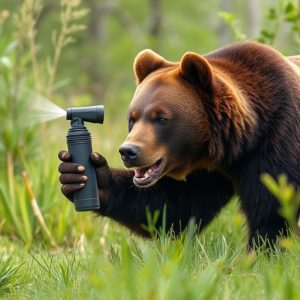Maximizing Bear Spray Range: Unlocking the Science and Effective Ingredients
Bear spray deters bears through capsaicin, a chili pepper-like ingredient that irritates respiratory…….
Bear spray deters bears through capsaicin, a chili pepper-like ingredient that irritates respiratory systems, combined with piperidinic acid and oils for stickiness. Effective range depends on wind, terrain, and spray volume, which users should understand to select the right bear spray and maximize safety during outdoor activities in bear country. Key practices include using high-quality sprays with potent ingredients like capsaicin or oleoresin capsicum (OC), testing functionality, aiming at bears' faces and eyes, practicing spraying techniques, and maintaining distance. Knowing what chemicals are in your bear spray ensures its effectiveness as a deterrent.
“Discover the power of bear spray as a vital tool for self-defense in encounters with these formidable creatures. Our article delves into the science behind its effectiveness, exploring the key chemicals that make it a powerful deterrent. We’ll uncover the factors influencing its range and provide best practices for optimal usage. Understanding the chemistry can mean the difference between safety and danger when facing bears. Read on to learn what chemicals are in bear spray and navigate these encounters with confidence.”
- Understanding Bear Spray Chemistry: Unveiling the Key Ingredients
- The Science Behind Effective Deterrent Ranges: What Impacts Protection?
- Maximizing Safety: Best Practices for Optimal Bear Spray Range and Application
Understanding Bear Spray Chemistry: Unveiling the Key Ingredients
Bear spray, a powerful deterrent for grizzlies and black bears, is more than just a mist of water. It’s a carefully formulated chemical solution designed to disrupt and deter aggressive bear encounters. Understanding what chemicals are in bear spray offers insight into its effectiveness and how it works from a scientific perspective.
The primary active ingredient in most bear sprays is capsaicin, the same compound that gives chili peppers their heat. This irritant substance targets the bear’s respiratory system when inhaled, causing temporary yet intense discomfort. In addition to capsaicin, other chemicals like piperidinic acid and various oils are often included. These additives enhance the spray’s effectiveness by increasing its stickiness, ensuring it clings to fur and coats the bear’s eyes, nose, and mouth—all sensitive areas. The combination of these key ingredients creates a potent barrier, giving humans precious time to escape or defend themselves during unexpected bear encounters.
The Science Behind Effective Deterrent Ranges: What Impacts Protection?
The effectiveness of bear spray as a deterrent is based on an intricate interplay of various factors, with the range being one of the most critical. Understanding the science behind these ranges is key to gauging the level of protection offered. The spray’s reach depends on the speed and dispersion of the aerosolized chemicals when deployed.
Bear spray contains capsaicin, the same chemical that gives chili peppers their heat. When sprayed, this irritant reaches the bear’s eyes, nose, and respiratory system, causing temporary disorientation and pain. The range at which this protection is effective varies based on factors like wind speed and direction, terrain, and the volume of spray dispensed. A good understanding of these variables allows users to choose the right bear spray for their specific environment, ensuring a safer outdoor experience.
Maximizing Safety: Best Practices for Optimal Bear Spray Range and Application
Maximizing Safety: Best Practices for Optimal Bear Spray Range and Application
When it comes to bear spray, understanding its effective range and proper application techniques is paramount for your safety in bear country. The range of bear spray varies depending on factors like wind conditions, terrain, and the specific chemical composition of the spray. It’s crucial to know that most bear sprays are designed to create a barrier of chemical irritants that deter bears when they come into contact with the spray or inhale its aerosolized particles.
To ensure maximum effectiveness, follow these best practices: choose bear spray with a proven track record and high concentration of active ingredients, such as capsaicin or oleoresin capsicum (OC). Always test the spray before heading into the field to ensure it’s functioning correctly. When applying bear spray, aim for the face and eyes of the bear—this area is highly sensitive to the chemicals. Practice your spraying technique in a safe environment to develop consistency and accuracy. Remember that distance is crucial; maintain as much space between you and the bear as possible while still being able to effectively reach it with the spray.
Bear spray, as a vital tool for outdoor enthusiasts navigating bear country, relies on specific chemicals to achieve an effective deterrent range. By understanding the science behind its composition and application, users can maximize safety during encounters with these majestic yet potentially dangerous animals. Key ingredients, such as capsaicin and pepper oils, work by stimulating pain receptors, creating a temporary but powerful deterrent effect. The range of bear spray is influenced by factors like wind conditions, terrain, and the user’s technique, emphasizing the importance of proper training and responsible usage. By following best practices outlined in this article, individuals can ensure they’re prepared with the knowledge needed to protect themselves effectively against bears.


